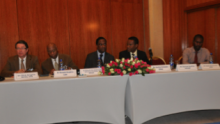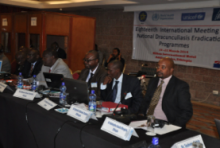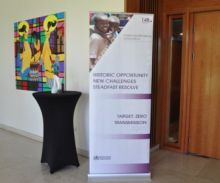Ethiopia poised to interrupt transmission of guinea-worm disease in 2014
High-level political commitment bolsters eradication campaign in endemic region of Gambella
Addis Ababa. 19 March 2014 – The World Health Organization (WHO) has confirmed the lowest-ever number of reported cases of guinea-worm disease since the eradication campaign began in the mid- 1980s. After more than 30 years of continuous struggle, only 148 cases were reported globally in 2013.
“The determined efforts of the world’s youngest country, South Sudan, have been a key factor in the 73% decline in the global number of cases,” said Dr Pierre M’pele-Kilebou, WHO Representative in Ethiopia, speaking today during the opening of the 18th International Review Meeting of National Dracunculiasis Eradication Programmes in Addis Ababa, Ethiopia. “We have never been so close to eradication, and this, despite new challenges. This progress is largely due to the relentless and collective work of thousands of health workers and volunteers.”
Guinea-worm disease (also known as dracunculiasis) is the first parasitic disease (and the second human disease after smallpox) on the verge of eradication. Today, there are only four endemic countries: Chad, Ethiopia, Mali and South Sudan. Three cases were reported across the border of South Sudan in Sudan in 2013, where the last indigenous case was recorded in 2002.
Challenges
Despite unprecedented progress in South Sudan, the greatest challenge remains insecurity and access to remote rural areas from where many of the cases are being reported. In Chad, a peculiar epidemiology of infection has been reported in a disproportionately large number of dogs along the Chari River.
In Ethiopia, low-intensity transmission has continued in a few villages in Gambella Region. In June 2013, a high-level advocacy mission there led by the Minister of Health, Dr Kesetebirhan Admassu called for renewed commitment to overcome challenges in this region. “The Federal Ministry of Health’s exemplary leadership and political will for the eradication efforts is notable. In a personal commitment to these efforts, the Minister brought the Guinea Worm Eradication Program under his direct supervision to personally review the progress on a monthly basis,” said Dr M’pele.
“We need the highest level of political support and advocacy to see us through this final phase of the eradication programme,” said Dr Dirk Engels, who takes over as Director of the Department of Control of Neglected Tropical Diseases in WHO from 1 May 2014. “The WHO Roadmap has targeted interruption of global transmission by 2015, and remains committed to support countries till global certification of eradication is achieved.”
Progress
During the past five years, the number of cases has continued to decrease steadily in response to scaling up of public health practices. These involve intensified surveillance and enhanced interventions in all endemic areas and those declared free of transmission; community sensitization; behaviour change communication; case-detection and prompt containment of cases; vector control; and increased access to improved drinking-water sources.
“Maintaining heightened surveillance by engaging communities and enlisting the support of national Integrated Disease Surveillance and Response systems and of other disease surveillance networks such as that for poliomyelitis until eradication is achieved are of utmost importance,” said Dr Gautam Biswas, Team Leader of WHO’s Dracunculiasis Eradication Unit. “The determination of the endemic countries and support from The Carter Center, UNICEF and other local partners have been crucial.”
The meeting in Addis Ababa will review current epidemiological status, surveillance, response systems, awareness of the general public on the cash reward announced by most countries, and level of preparedness in countries in the pre-certification stage.
Partnership
Eradication efforts are undertaken in a partnership effort of WHO, The Carter Center and UNICEF under the leadership of the Ministries of Health, and with the support of DFID and the Bill and Melinda Gates Foundation. CDC and ICCDE are also partners in this effort.
Disease prevalence and certification
In 1947, more than 48 million people were estimated to be affected by the disease in Africa and Asia. WHO estimated a prevalence of 10 million guinea-worm disease cases globally in 1976. In the mid- 1980s, there were an estimated 3.5 million cases in 20 endemic countries in Africa, the Middle East and Asia.
Today, 197 countries, territories and areas (belonging to 185 WHO Member States) have been declared free of guinea-worm disease by WHO on the recommendation of the International Commission for the Certification of Dracunculiasis Eradication.
The latest to attain this status in December 2013 include formerly endemic countries Côte d’Ivoire, Niger and Nigeria as well as Somalia and South Africa, which have no previous history of guinea- worm disease.
Eradication
Dracunculiasis is a crippling parasitic disease caused by Dracunculus medinensis, a long thread-like worm. The disease, which has afflicted humanity for centuries, is transmitted exclusively when people drink water contaminated with parasite-infected water fleas.
The WHO Roadmap on neglected tropical diseases targets global interruption of transmission by 2015. With remaining endemic countries showing robust political support and a stronger determination, a high level of public motivation is required to eradicate the disease.
For more information, please contact:
Dr Zeyede Kebede zelekez [at] who.int
Tel: +251-915 954 721
or
Loza Mesfin tesfayel [at] who.int
Tel: +251-911 144 194.





